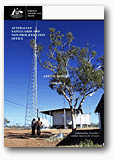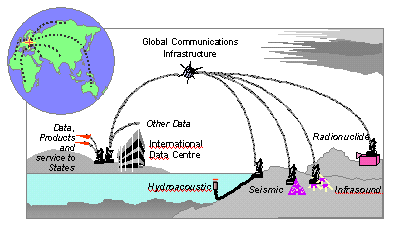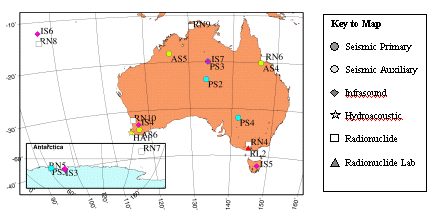


Annual Report 1998-99 |
 |
COMPREHENSIVE NUCLEAR-TEST-BAN TREATY
THE INTERNATIONAL MONITORING SYSTEM
States which are party to the CTBT undertake not to carry out any nuclear weapon test explosion or any other nuclear explosion. The Treaty envisages two key components for a verification mechanism: a system of monitoring stations to detect events which may signal a nuclear test event, and a ‘challenge type’ On-Site Inspection to investigate such an event or other serious concerns about non-compliance.
The IMS is a network of over 300 facilities spread throughout the world. A basic design parameter is that the network should be able to detect and locate a nuclear explosion of one kiloton or more which has been carried out in any terrestrial environment.
Figure 3. The International
Monitoring System.
Adapted from CTBTO

The IMS will gather data using four different monitoring technologies:
- IMS seismic stations are highly sensitive monitors of the acoustic waves generated by physical events such as explosions or earthquakes. The waves from such events are transmitted through the earth or along its surface and can be ‘detected’ at great distance. Analysis of signals can usually determine the nature of a seismic event, and effectively discriminates between natural seismic activity and something which may be the result of an explosion.
- Seismic stations in the CTBT network may either be an array of individual monitoring elements or a single seismometer; placed down boreholes or in a shallow surface vault.
- Infrasound monitoring detects sound waves generated by an explosion which are transmitted through the atmosphere. An infrasound station detects atmospheric pressure variations (waves)—and is tuned to be most sensitive to very low frequencies where signals from an explosion can be identified. To minimise the effects of wind and other local noise, pressure sensing elements are coupled to the atmosphere through large pipe arrays which act to ‘average out’ signals which are not coherent across the array.
- Hydroacoustic stations listen for acoustic signals from explosions that are carried through the oceans. Water is a very efficient medium for sound transmission and detection of quite small explosions is possible at great distance. The IMS includes two types of hydroacoustic stations:
- hydrophone arrays which place monitoring equipment in the ocean at a depth of about 1km where sound transmission is at its most efficient; and
- T-Phase stations which are located on islands, where acoustic signals from the ocean are well coupled with the land, and can be detected using seismic monitoring equipment.
- Radionuclide monitoring stations sample air and analyse the contents of radioactive species in the atmosphere. Sampled air is passed through a filter which traps particulates (or certain gases). Analysis of filters provides information on the concentration of radioactive species and is designed to detect species which would be the product of a nuclear test.
The data generated by these stations are transmitted to the CTBT International Data Centre (IDC) in Vienna. The task of the IDC is to identify events which may represent an explosive nuclear test. Parties to the CTBT are entitled to receive regular reporting on information gathered through the IMS, and can access detailed data to enable them to form their own judgements about compliance with the Treaty.
The location and specification for the 337 monitoring stations of the IMS was developed by technical experts during the negotiation of the Treaty, including some existing facilities. Although responsibility for managing IMS facilities rests with host governments, the cost of installing or upgrading stations, and of operating most stations, is funded from the contributions of CTBT signatories.
Australia will have 20 IMS stations and one radionuclide analysis laboratory. This is the third largest number of any country (after the United States and Russia), which is largely a reflection of Australia’s geographical size and location, and our Antarctic presence. Figure 4 shows the location of stations to be hosted by Australia.
Figure 4. Australia will host
21 IMS facilities, covering all CTBT Technologies.
Map courtesy of AGSO
